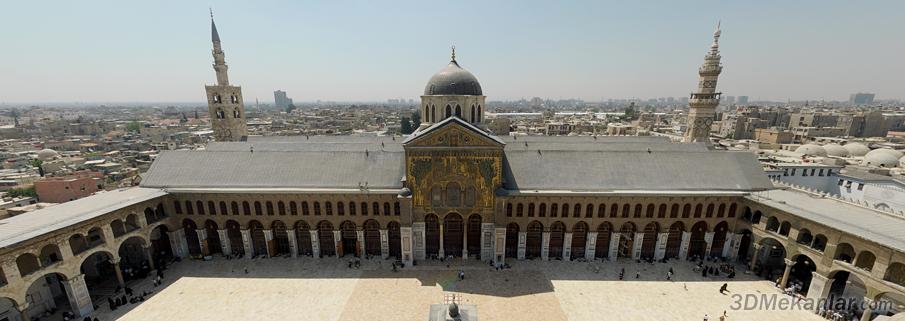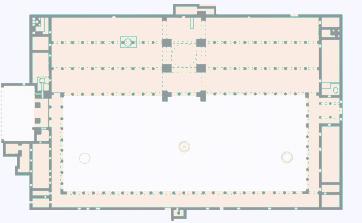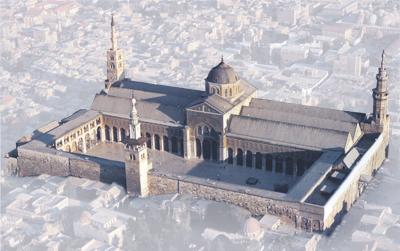

|
Umayyad Mosque (Damascus) - 3D Virtual Tour
Umayyad Mosque (Damascus) virtual tours can be started by clicking the preview window or by downloading the stand-alone versions. Just drag the mouse to the direction you want to look. Use the scroll wheel to zoom at the details. Press F9 to get a list of the 3D sites you downloaded (residing in the same directory). To install the listed sites as a screensaver press F5. Our advise is to install all the sites, including Umayyad Mosque (Damascus), as a screensaver. When the screensaver starts, a random site is chosen and shown around automatically (this gives the impression of looking at a documentary in HD quality). To see the usage of other keys press F1. Press Ecs to exit.
———
Right in the heart of the ancient city of Damascus, stands the old Umayyad Mosque, God's house and sanctuary of a spectacular civilization. Whereas Damascus is dubbed "the realm of domes and minarets", and known as a gateway to history, it is herein where one can locate the epitome of its grandeur, the utmost of its marvels and the starting point of its glory. On entering this perpetual edifice, one would at once face an immortal postulate of history: Here stopped the course of time one day, to relate the saga of Islam's majesty!
This mosque stands in fact as a living testimony to the great Golden Age of Islam, when the esteem of Damascus was unmatched allover the ancient world, as a capital of a great Arab-Muslim Empire, encompassing a host of kingdoms. In the eighth Century, the borders of this Empire spanned altogether vast lands, extending from the Caucasus Highlands in the north, to the Great Sahara southward, and from the Great Wall of China eastward, to the Iberian Peninsula and the Atlantic Ocean westward.
 The sacred spot, where the mosque was built, served for over three millennia as a place of divine worship. The Aramean king Hazael, who had taken over power in 805 B.C., built a sumptuous temple for “Hadad Rimmon”, the pagan god of rain and thunder. This became one of the greatest Syrian temples, until it was savagely destroyed by the Assyrian king Tiglet Pilaser, 732 B.C. In the aftermath of the Roman conquest of Syria 64 B.C., led by Pompeius, the temple was converted to serve Jupiter (another configuration of Hadad and Zeus), of which still remain ancient vestiges, as the southern gate and parts of the outer sanctuary (the Peribolos). Later on, during the apogee of Christianity in Europe, the Roman Emperor Theodosius I (379-395 A.D.) converted the extant temple to an imposing church, devoting it to St. John the Baptist, the building of which was completed by his son Arcadius (395-408 A.D.).
The sacred spot, where the mosque was built, served for over three millennia as a place of divine worship. The Aramean king Hazael, who had taken over power in 805 B.C., built a sumptuous temple for “Hadad Rimmon”, the pagan god of rain and thunder. This became one of the greatest Syrian temples, until it was savagely destroyed by the Assyrian king Tiglet Pilaser, 732 B.C. In the aftermath of the Roman conquest of Syria 64 B.C., led by Pompeius, the temple was converted to serve Jupiter (another configuration of Hadad and Zeus), of which still remain ancient vestiges, as the southern gate and parts of the outer sanctuary (the Peribolos). Later on, during the apogee of Christianity in Europe, the Roman Emperor Theodosius I (379-395 A.D.) converted the extant temple to an imposing church, devoting it to St. John the Baptist, the building of which was completed by his son Arcadius (395-408 A.D.).
The Muslim troops conquered Syria, under the leadership of the famed Khaled b. Al-Walid, in 634 A.D., to meet but with a scattered and helpless resistance on the Byzantine side. Soon, in 635, Damascus became a Muslim city. During the next 72 years, the inhabitants of the town, Muslims and Christians alike, partook the holy site as a combined temple, comprising a mosque and a church alongside. Later, the Caliph Al-Walid bade the erection of a great monumental mosque, to accommodate the ever-growing numbers of the faithful, and to glorify his imposing realm.
In the year 705 A.D. was the outset of Al-Walid's work. He used the ancient inner wall of the Temenos, as a framework for his new building, with a slight enlargement to the west. A host of the highest-level workers, architects and artists was brought over, from Persia, India and Byzantium, as well as piles of the finest working materials, such as marbles, mosaics, gold, silver and rare paints. Ibn al-Fakih al-Hamadhani wrote that Al-Walid spent, for his costly project, all the state tax-revenues for full seven years!
The process of building the mosque lasted allover the reign of Al-Walid (705-715 A.D.), but when it was finally completed, it turned out to be a peerless work of art and architecture, a marvelous monument that soon was reckoned as one of the world's wonders. As to Damascus, the mosque remained an eternal legacy, in spite of frequent quakes and blazes (the last of which was in 1893). The main point of interest about it, is that it was set without a previous example, but was rather a combination of ancient Syrian temples, with an east Roman flavor. The design of the prayer-hall consists of three transverses, covered with elegant gabled roof, lying on arched arcades. The three naves are also crossed by a lofty transept, carrying a large truncated dome. All parts were covered with fine marble and embellished with mosaic.
Since the era of Al-Walid, the mosque had 3 minarets: The one known as “the Bride”, for its graceful looks; the minaret of Jesus, in the east of the mosque; then the western minaret, or Qayitbey's, undoubtedly the most gorgeous of all Damascus' minarets. Among its most prominent features is the sublime Dome of the Eagle, overlooking old Damascus, with its gabled transept and rich front façade. The mosque has 4 doors: Al-Kallassa in the north, Jayrun in the east, Al-Brid in the west, and Al-Ziyada in the south (known today as the goldsmiths'). The Great Mosque also contains a noteworthy religious relic: The tomb of the prophet Yahia (St. John the Baptist), in the eastern hall.
Apart from being one of the finest examples of Muslim architecture, the Great Mosque of Damascus has founded the original principles of its innovated concepts. For it was the first mosque in Islamic history to feature such luxury and large size. Although this depended somehow on the ancient Syrian patterns, the touch of Muslim workmanship was still evident. Its rise marked the emergence of independent style of architecture and decorative art, helping thus to encarnate a new personality with a firm identity. Moreover, it is beyond doubt the oldest extant mosque, allover the Islamic world.
Another characteristic feature about this mosque, is that it was built upon a rectangular plan, instead of square. While the tasteful Arabic touch of arched colonnade embodied an allure of elegance, which became afterwards one of the preliminary rules of Muslim architecture. Several sovereigns through history were fascinated by this monument, thus the Caliph Suleyman built in Aleppo a meticulous replica. And when AbdulRahman I determined erecting the Great Mosque in Cordoba (La Mezguita), 687 A.D., he resolved to have it done following the fashion of Damascus' masterpiece. This claims no wonder, as it was an optimum assimilation for the core of Muslim civilization, including its new vision.
It should be noted that the “Mihrab” (niche), known as “the Mihrab of Companions of the Prophet”, is the oldest of its type allover Islamic history. As to the nifty minaret so-called “the Bride”, it became as a fashion template for the large mosques of North Africa. But what really individualizes the Mosque of Damascus, is its mosaic clad panels, made of millions of tiny cubes of glassware, stained or guilded, in lustrous drawings, depicting vivid landscapes and city views, the most renowned of which is the Barada panel, in the western portico. This fine art was a combined mixture of Persian and Roman elements.
In the northern flank of the mosque, stands the mausoleum of a great Muslim sovereign: The glorious Sultan Saladin, who, during 19 years of his reign in Egypt and Syria, took the oath of fighting the Latin invaders, i.e. the Crusaders. After a long strife of fierce warfare, he could achieve a decisive victory over their troops, and was even able to capture their King and barons, in the battle of Hittin, 1187 A.D. This was shortly followed by the liberation of the holy city of Jerusalem, with other strongholds. A few years later, Saladin bade Palestine farewell, to come back to his beloved childhood place, Damascus, where he died and was buried.
Among many functional sections, the mosque contains four memorial halls, dedicated to the four successors of the Prophet Mohammad. The one located in the eastern side carried the name of Imam 'Ali, but later on it was called after his grandson, Zein Al-'Abidin, where a special cenotaph was devoted for the head of the martyr Al-Hussein b. 'Ali. Hence the respect bestowed over this shrine today.
Throughout the extended history of the Great Mosque of Damascus, several constructions emerged within its limits. To name but a few: The Dome of the Treasury, in the western side of the court, the dome of the clocks, eastward, (of which a vivid description was written, back in 580 A.H., by Ibn Jubayr). Also, the Podium of Oratory, as well as many schools, such as al-Ghazaliah.
Source: A.N. Ibesch
